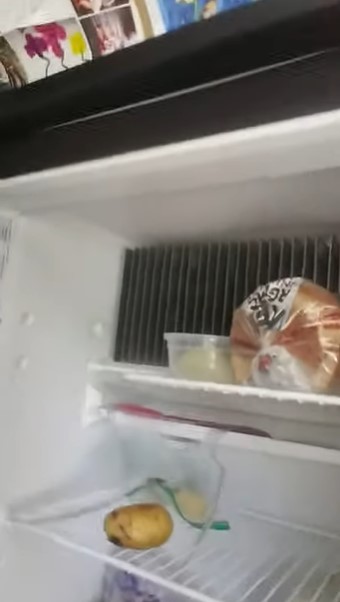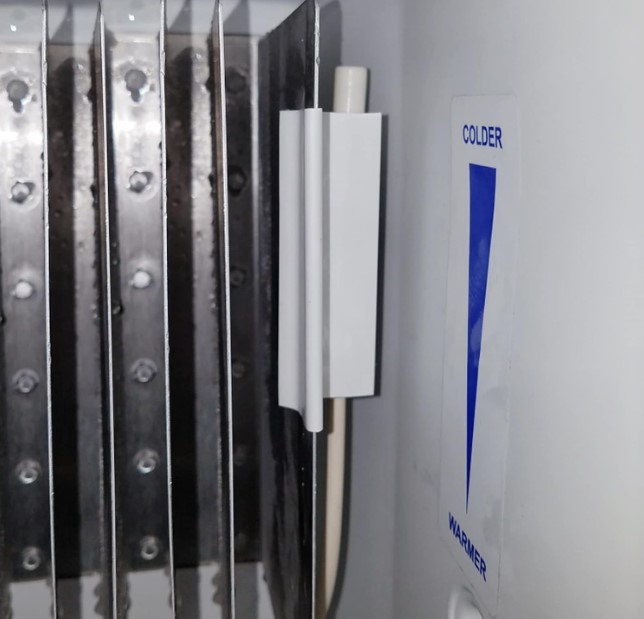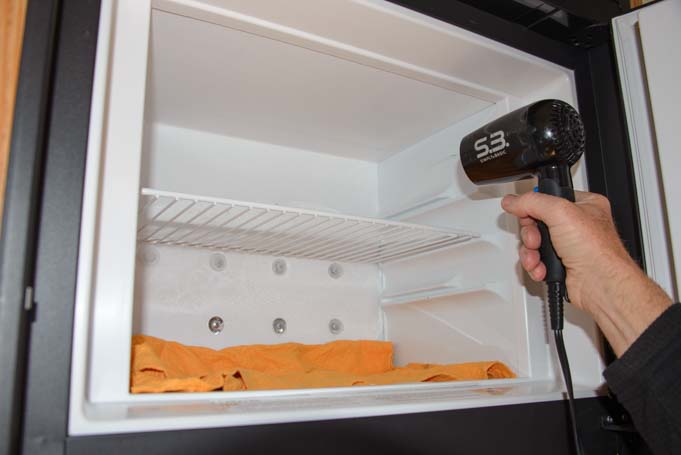To prevent your RV fridge from freezing, monitor the temperature settings and ensure proper ventilation. Pack your fridge responsibly by allowing air to circulate freely.
Traveling with an RV brings the comfort of home on the road, but maintaining this convenience, like keeping your fridge at the right temperature, can be a challenge. Every RV enthusiast knows that a functional refrigerator is key to a well-stocked and enjoyable journey.
Yet, too often, items freeze when they shouldn’t, wasting food and dampening the travel experience. Managing the cold can be simple with strategic fridge packing and regular temperature checks.
By understanding your RV fridge’s mechanics and being mindful with your food storage, you’ll keep your edibles fresh and your drinks chilled to perfection, without the icy surprise. This balance ensures your adventures are fueled by well-preserved meals, no matter where the road takes you.

What Does RV Fridge Freezing Means?
Traveling in an RV offers the comfort of home on the road, including the luxury of fresh food and cold drinks from your refrigerator. But sometimes, you might find your RV fridge gets a bit too cold and starts to freeze your supplies.
Preventing your refrigerator from freezing is essential to maintaining the quality of your food and ensuring the longevity of your fridge.
Let’s delve into the causes and effects of RV fridge freezing to better understand how to keep your food in perfect condition during your travels.
Causes Of RV Fridge Freezing
Several factors can contribute to your RV fridge’s overzealous cooling tendencies. Understanding these can help you take the necessary steps to prevent freezing issues:
- Thermostat Settings: The most common cause is incorrect thermostat settings where the temperature is set too low.
- Blocked Vents: Airflow restrictions due to blocked vents can lead to uneven cooling and freezing.
- Overstocking: Overfilling the fridge can obstruct airflow, causing certain areas to get too cold.
- Outside Temperature: Extreme outside temperatures can also affect the fridge’s internal temperature balance.
- Levelness of RV: RV fridges rely on gravity for proper cooling function; being off-level can disrupt performance.
Effects Of Freezing On RV Fridge
When your RV fridge freezes, the consequences can range from mildly inconvenient to costly:
- Food Spoilage: Fresh produce and other foods can suffer from freezer burn and spoilage when frozen unintentionally.
- Energy Waste: A freezing fridge often leads to more energy consumption as the unit works harder than necessary.
- Component Stress: Continuous freezing puts extra strain on the cooling unit, potentially leading to premature failure.

Regular monitoring and timely adjustments ensure your trip is smooth, your food fresh, and your fridge functioning optimally. Stay tuned as we explore solutions to keep your RV fridge at just the right temperature.
How to Keep RV Fridge from Freezing: The Steps
RV refrigerators are notorious for their finicky temperature control, especially in hot weather. It’s a common struggle to keep food chilled without accidentally freezing everything solid.
Here are some tips to help you strike that perfect balance:
Temperature Control Techniques
Maintaining the perfect temperature within your RV fridge is crucial to prevent your food from freezing. Inadequate temperature control can lead to frozen produce and wasted provisions.
Effortlessly manage your RV fridge’s chill with these essential strategies, ensuring your edibles remain fresh and free from the unwanted deep freeze.

Optimizing RV Fridge Temperature
The first step toward optimal temperature regulation is understanding your RV refrigerator’s unique characteristics. Unlike residential units, RV fridges depend on absorption refrigeration, which can behave differently.
- Start by setting the thermostat to a mid-range level.
- Adjust incrementally, as extreme temperatures can overshoot your ideal range.
- Consider ambient temperatures, as hotter or colder climates will affect your fridge’s efficiency.
- Ensure proper ventilation, as a well-ventilated fridge operates more effectively.
- Check seals and gaskets regularly for any signs of wear or leaks.
Use Of Thermometers For Monitoring
Continuously tracking the internal temperature of your RV fridge can be the difference between preservation and freeze. Implement reliable thermometers for live updates and peace of mind:
| Thermometer Type | Features | Placement |
|---|---|---|
| Analog | Basic and budget-friendly | Place in the center |
| Digital | Offer precise readings | Multiple placements for large fridges |
| Wireless | Monitor from a distance | Anywhere with signal coverage |
Regularly check the thermometer, preferably daily, to observe any fluctuations and take timely actions:
- Record temperatures at different times of the day.
- Adjust settings based on readings and note the changes.
- Keep a log to spot trends or issues.
Insulation And Airflow Solutions
Ensuring that your RV fridge operates efficiently without freezing is a matter of mastering insulation and airflow solutions. These actions prevent unwelcome frost from building up and keep your perishables at the perfect temperature during your travels.
Follow along to explore the steps you can take with proper insulation techniques and airflow management within your RV fridge to combat the cold and maintain ideal conditions for your food and beverages.
Bold strategies and smart modifications will transform your RV fridge into a reliable companion on the road.

Proper Insulation Methods
Effective insulation is the first line of defense in preventing your RV fridge from freezing. Start by assessing the exterior seals and interior lining. Make sure the seals are intact and not allowing any external air to seep in, which could cause overcooling. Check for any signs of wear or gaps and replace the seals if necessary.
For the interior, consider using insulating panels specially designed for fridges. These can help maintain consistent temperatures.
- Check door seals for wear and replace if needed
- Install insulating panels within the fridge
- Use weather stripping for additional insulation around edges
Additional options include using thermal curtains or blankets to cover your fridge during extreme temperature drops, particularly if parked in a location prone to cold weather. These can be draped over the unit overnight to add an extra layer of thermal protection.
Managing Airflow Within The Rv Fridge
Proper airflow within your RV fridge ensures even temperatures throughout and can prevent areas from becoming too cold. Begin by organizing your fridge contents to allow for free movement of air. Avoid overcrowding, as this can block vents and lead to cold spots.
| Location | Action | Benefit |
|---|---|---|
| Vents | Keep clear of obstructions | Promotes consistent airflow |
| Shelves | Arrange items with spaces between | Reduces risk of freezing |
| Interior | Add a battery-powered fan | Circulates air to even out temperature |
Consider the installation of a small, battery-operated fan inside the fridge to boost circulation. This keeps the air moving and helps to balance out the temperature in every corner of the fridge, thereby greatly diminishing the chances of freeze-up.
Stay mindful of the temperature settings as well. Adjust the thermostat according to the ambient temperature and the fridge’s contents. If the fridge continues to freeze, incrementally increase the temperature setting until it stabilizes.
Maintaining your RV refrigerator free from freeze issues is achievable with diligent care and implementation of the correct insulation and airflow practices. These strategic moves protect your edibles and contribute to a fuss-free, enjoyable journey!
Defrosting and Maintenance:
Embarking on a road trip in your RV evokes a feeling of freedom, but it’s essential to keep a keen eye on maintenance to prevent mishaps, including the refrigerator freezing your food unexpectedly.
Routinely maintaining your RV refrigerator not only helps in preventing freeze-ups, but it also improves efficiency and extends the lifespan of your appliance. These preventive maintenance tips are crucial for any RV owner to ensure a smooth and hassle-free journey.

Regular Defrosting Practices
Defrosting your RV fridge regularly is key to maintaining its efficiency. Ice buildup can lead to uneven cooling and can put extra strain on the fridge’s components. Here are steps to ensure proper defrosting:
- Turn off the refrigerator and remove all contents.
- Prop the doors open to allow air circulation and speed up the defrosting process.
- Place towels or a tray at the bottom to catch the water as the ice melts.
- Wipe down the interior once the ice has melted and the surface is dry.
Implementing a routine defrosting schedule, perhaps every couple of months, depends on use and climate conditions.
Cleaning The Rv Fridge Coils
Similar to defrosting, cleaning your RV’s fridge coils on a regular basis contributes significantly to preventing freezing problems. Dirty coils can cause the fridge to work harder than necessary, leading to frost issues and reduced efficiency. Follow these steps:
- Ensure your fridge is turned off and unplugged before starting.
- Access the coils from the back of the fridge or via the exterior vent panel on your RV.
- Use a soft brush or a coil cleaning brush to gently remove dust, pet hair, and debris.
- For more thorough cleaning, use a vacuum with a brush attachment to gently suction off the loosened debris.
Clean these coils every six months, or more often if your RV is frequently on dusty roads or has pets on board.
Additional Tips And Best Practices
Discover some of the best tips and practices to prevent your RV fridge from turning into a freezer. Whether you’re parked for the night or constantly on the move, these simple adjustments and accessories can ensure your perishables remain perfectly chilled without the risk of freezing.
Organizing Fridge Items Efficiently
Organizing the contents of your RV fridge not only keeps things neat and accessible, but it also plays a vital role in maintaining the correct temperature. Here are some efficient organization tips:
- Keep ample space between items: This allows for better air circulation, preventing cold spots that can lead to freezing.
- Store sensitive items in the warmer zones: Typically, areas like the refrigerator door and the top shelf are slightly warmer. Use these spaces for items more susceptible to freezing.
- Use crisper drawers: These drawers are designed to hold items at a higher temperature, ideal for fruits and veggies.
- Rotate items regularly: Move items around to avoid prolonged exposure to the coldest parts of the fridge.
Food Storage and Habits:
Organizing the food items of your RV fridge not only keeps things neat and accessible, but it also plays a vital role in maintaining the correct temperature.
Here are some efficient food storage and habits tips:
- Don’t overfill it: Leave some space around your food for air to circulate. Overcrowding can trap cold air and lead to freezing.
- Pre-chill food and drinks: Chill food and drinks before putting them in the fridge to reduce the initial load on the cooling system.
- Avoid hot items: Don’t put hot food directly in the fridge. Let it cool down first to prevent the temperature from spiking.
- Keep the door closed: This seems simple, but avoid opening the fridge door too often or for extended periods. The cold air escapes quickly, and the fridge has to work harder to cool back down.
Using Refrigerator Accessories For Rv Efficiently
Enhance your RV fridge’s performance and prevent freezing by incorporating these helpful accessories:
| Accessory | Function | Benefit |
|---|---|---|
| Thermometer | Monitors temperature | Ensures fridge maintains a safe temperature to avoid freezing. |
| Fridge fan | Improves air circulation | Prevents cold spots and promotes even cooling throughout the fridge. |
| Space organizers | Maximizes storage | Assists in efficient organization, preventing overcrowding and allowing air to circulate properly. |
| Temperature controller | Adjusts fridge’s cooling cycle | Keeps the fridge running at the perfect temperature, reducing the risk of freezing. |
Investing in a few well-chosen accessories can significantly improve your RV refrigeration experience. A few strategic purchases combined with smart organization can protect your perishable goods from the icy grip of an overzealous refrigerator.
Dometic RV Fridge Freezes Everything
If a Dometic RV fridge is freezing everything, it may be due to a faulty thermostat or a malfunctioning temperature control. Check the thermostat setting and adjust it to a slightly higher temperature. Additionally, ensure that the fridge vents are not blocked, and the door seals are in good condition to maintain proper airflow and temperature control.

Norcold RV Refrigerator Freezing Food
When a Norcold RV refrigerator is freezing food, it could be related to a similar issue with the thermostat or temperature control. Check the thermostat settings and adjust them accordingly. Also, inspect the seals, vents, and ensure proper ventilation to prevent overly cold temperatures within the refrigerator compartment.
RV Fridge Fins Icing Up
Icing up of the fins in an RV fridge could be a sign of inadequate ventilation or a defrosting issue. Check for any obstructions around the fridge vents and ensure proper airflow. If the problem persists, there may be an issue with the defrost mechanism, requiring professional inspection and repair.
Dometic RV Refrigerator Thermistor Adjustment
To adjust the thermistor in a Dometic RV refrigerator, locate the thermistor—a small device typically clipped onto the cooling fins inside the fridge. Moving the thermistor up or down on the fins can impact temperature control.
Refer to the refrigerator’s manual for specific instructions on adjusting the thermistor for optimal performance.
Norcold RV Refrigerator Too Cold
If a Norcold RV refrigerator is too cold, the thermostat settings may need adjustment. Ensure the thermostat is set to the desired temperature. Additionally, check for proper ventilation and inspect the seals to maintain consistent temperatures without overcooling.
RV Fridge Thermostat
The RV fridge thermostat controls the temperature inside the refrigerator. Users can adjust the thermostat to regulate the cooling level. If experiencing temperature-related issues, inspect the thermostat settings and ensure it is functioning correctly. In some cases, a faulty thermostat may need replacement.
Dometic RM2652 Freezing Everything
The Dometic RM2652 freezing everything could be due to a thermostat malfunction or improper temperature settings. Check the thermostat and adjust it to a slightly higher temperature. Inspect the fridge vents, seals, and ensure proper ventilation to prevent excessive cooling. If issues persist, professional assistance may be necessary to diagnose and address the problem.
FAQs: How To Keep RV Fridge From Freezing?
Why Does My Rv Fridge Keep Freezing?
A common cause of RV fridge freezing is incorrect thermostat settings. Adjust the thermostat slightly higher to prevent items from freezing. Ensure the fridge isn’t overly packed to allow proper air circulation, which helps maintain consistent temperatures.
What Temperature Should My Rv Fridge Be At?
Your RV fridge should ideally be at a temperature between 34°F and 40°F (1°C to 4°C) to keep food fresh without freezing. Use a fridge thermometer to monitor and maintain this range for optimal performance.
How Can I Prevent Frost Build-up In My Rv Refrigerator?
To prevent frost build-up, reduce humidity levels by covering food and minimizing the fridge door opening. Also, defrost regularly and ensure the door seals are clean and intact to keep cold air in and warm air out.
Are There Rv Fridges With Auto-defrost Settings?
Yes, there are RV fridges on the market that feature auto-defrost settings. These models can automatically manage the defrost cycle to prevent ice build-up, offering convenience and maintenance ease.
Conclusion
Maintaining the right temperature in your RV fridge ensures your food stays fresh and avoids unnecessary freeze-ups. By following the tips outlined in this post, you can achieve the perfect balance and enjoy your road trips without the hassle of defrosted goods.
Safe travels and happy camping!
